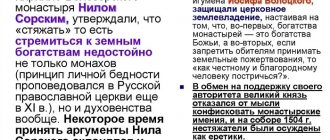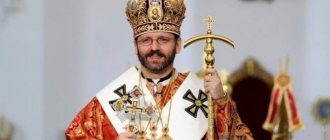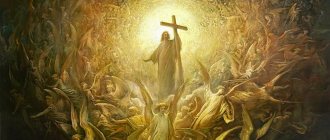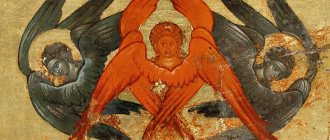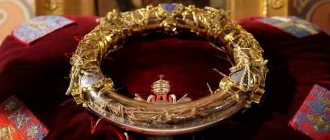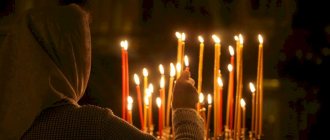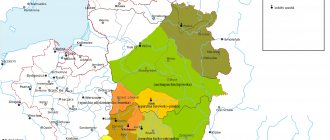— The desire of stronger minds to place the Christian teaching, given as a revelation of God, on the same level with the philosophical and dialectical methods of the latter. These teachers had a good intention, but by the very nature of things it was impossible to fulfill; it led to rationalism, which was the inspiration for the most powerful heresy of the early Middle Ages - Arianism with its varieties.
The arrogance and conceit of the philosophers who lived in the time of the apostles were the cause of heresies in the early church and, according to Hobbes. “They were able to reason more subtly than other people and more convincingly. When they converted to Christianity, they almost inevitably found themselves elected presbyters and bishops to defend and spread the faith. But even having become Christians, they, as far as possible, preserved the teachings of their pagan mentors and therefore tried to interpret the Holy Scriptures, wanting to preserve the unity of their philosophy and the Christian faith.” “In the early church, right up to the Council of Nicea, most of the dogmas that caused controversy among Christians concerned the doctrine of the Trinity, the mystery of which, although recognized by all as unknowable, many philosophers tried to explain each in their own way, relying on the teaching of their mentors. From here, first, disputes arose, then squabbles, and finally, in order to avoid indignation and restore peace, councils were convened, not at the direction of the rulers, but at the voluntary request of bishops and pastors. This became possible when the persecution of Christians stopped. At these councils they determined how the issue of faith should be resolved in controversial cases. What was accepted by the council was considered the Catholic faith, what was condemned was heresy. After all, the cathedral in relation to the bishop or pastor was the Catholic Church, i.e. comprehensive, or universal, like their opinion in general (opinio); a separate opinion of any priest was considered heresy. This is where the name of the Catholic Church comes from, and in every church, Catholic and heretic are correlative names.”
- Original theology of Christian teachers on the basis of Holy Scripture and the pure principles of reason, devoid of the guiding principles legitimized by the church - church tradition and the general voice of the Universal Church.
In addition to the indicated three categories of teachings - heresies, schisms, unintentional mistakes of church teachers, outside the symbolic, universally binding teachings of the church for all Christians there are also the so-called. private, or personal opinions of church teachers and church fathers on various detailed issues of Christian teaching, which the church does not authorize in its name, but does not deny either.
However, it should be recognized that the above, with all its validity, is not able to explain why purely dogmatic disagreements with church teaching resulted in powerful mass movements, if we leave aside the social background of such a phenomenon as heretical movements. The march of Christianity was accompanied by a fierce class struggle, which was waged within Christian organizations, the exploitation of the masses of believers by the church hierarchy, later with bishops at the head, and bloody methods of suppressing protest against the churchmen, who were becoming already in the 3rd century. major political force. However, even staying on the basis of theological sources, one can trace from the 2nd and 3rd centuries a continuous line of class struggle of the masses, already intoxicated by Christianity, clothed in the religious form of heresy, among other things, in an attempt to reorganize the church, to return it to its “original simplicity.”
It was this simplicity that most often attracted large masses of people to sects and made the ideas of heresiarch teachers popular. Tertullian, describing the behavior of heretics, notes how “frivolous, worldly, ordinary” it is. “It is unknown who their catechumens are, who is faithful. ... Since they differ from each other in their beliefs, they don’t care, everything is suitable for them, as long as more people join them in order to triumph over the truth.” The simplicity of the internal structure of heretical sects, the simplicity of the relationships between heretics are the main reasons for the popularity of sects, with the exception of those that were distinguished by strict asceticism, which proves the correctness of the above. In addition, within a heretical organization it was possible to quickly rise in rank: “nowhere do people rise in rank so quickly as in the crowds of rebels” and this is regardless of social status, “which is why they have no or imperceptible strife.”
The early Christian period is characterized by an abundance of heresies. Celsus already mentions a number of heresies of pneumatics, psychics, sibilists and others: “Some declare themselves Gnostics... some, recognizing Jesus, want to live with him according to the law of the Jews (Ebionites).” Celsus also mentions the Marcionites, led by Marcion. Jerome, in his letter to Augustine, writes that there is a heresy among the Jews, which is called the Minaean; "they are usually called Nazarenes." In addition, we can list the following heresies of the first period: Cerinthianism, Elkesianism, Docetism, Manichaeism, Montanism, Chiliasm. In the doctrine of the Trinity, triadological heresies arose, such as Monarchianism, Arianism, the heresies of the Eunomians, Anomeans, Eudoxians, Semi-Arians or Doukhobors, Sabellians, Fokinians, Apolinarians, etc.
Molokans (18th century - our time)
In the Russian Empire, the Molokans were recognized as “especially harmful heresies.” Unlike many sects, they accepted the Bible. According to their faith, it is associated with the image of spiritual milk that feeds a person. This is where the name of this movement comes from.
They, like many heretics, rejected the church institution and traditional church rituals. The main clergyman of the Molokans was an elder. The service consisted of the singing of psalms and spiritual verses and the reading of the Bible aloud.
Molokans. Source: pinterest.com
There was also a division within the Molokans: “wet Molokans” (they practiced water baptism), spirit-and-zhizniks (for them the third part of the Bible was the book Spirit and Life), Molokans-jumpers (they were against the dominance of the elders) and Molokans-subbotniks.
Patristic teaching on dogma and heresy
Dogma.
Like many Christian terms, the word “dogma”, as a rule, is used in conversation and in the media in a distorted form, and the word is given a negative connotation of something deadening, frozen in stagnation. In fact, the word το δόγμα comes from the Greek verb δοκει̃ν, which means “to think, believe, believe.” But “δόγμα” no longer means an opinion, but the end result - a firm conviction, a position that has become the subject of agreement, or a religious truth that has become the subject of undoubted faith [1].
Therefore, even in ancient Greco-Roman antiquity, the term “dogma” began to be applied to this kind of philosophical teachings that were generally known and indisputable. In Plato’s dialogue “The State,” dogmas are the decrees and decisions of the government related to the concepts of the just and the beautiful. St. Isidore called Socrates “the Lawgiver of Attic dogmas,” and the teachings of Plato and the Stoics – dogmas. Dogmas in the same sense could be called by ancient church writers the religious beliefs of the pagans (Sozomen) and heretical false teachings (Eusebius of Caesarea), as having claims to assimilate undeniable truth.[2]
In the Holy Scriptures in the book of the Acts of the Holy Apostles, dogmas are called apostolic definitions that are directly related to the life of the Christian Church. “As they went through the cities, they (the apostles Paul and Silas) conveyed to the faithful to observe the regulations (τα δογματα) decreed by the apostles and elders in Jerusalem” (Diary 16:4). These were the doctrinal and disciplinary decisions of the Apostolic Council, which had the force of binding law for all members of the Church of Christ.
However, by the 4th century the Church gradually separated the concepts of “dogma” and “canon”. The very word “dogma” began to be applied only to subjects of religious doctrine, and moral commandments and issues of church discipline began to be designated by the terms “canon” and “rule.” The truths of faith began to be called dogmas, in contrast to liturgical, canonical, moral truths, etc. Moreover, it is especially important that at the Ecumenical Councils the word “dogma” was used only for doctrinal truths that have an undoubted, indisputable and immutable character. Rev. Vikenty Lirinsky writes: “It is not common for the dogmas of heavenly philosophy to be subject to any change, cutting off or mutilation, like an earthly institution, which can only be improved by continuous amendments”[3].
The expression “dogma”, used in dogmatic theology, denotes a precisely expressed, unchangeable truth in the Church consciousness, which has 4 characteristics:
1) Creed or Theology. This feature fundamentally distinguishes dogmatic truths from moral and other truths, for dogmatic truths always speak about God and His relationship to the world and man, and for moral truths the main subject is man in his relationship to God
2) Divine revelation. This feature characterizes dogmas as truths revealed to people by God Himself in His Divine Revelation
3) Churchness. This sign indicates the environment in which dogmas exist, namely the Church of Christ is the only legal owner, custodian and interpreter of dogmatic truths
4) Legality. A person who does not recognize the totality or some part of the dogmas of the Church, regardless of the volume of unrecognized Divinely revealed truths, cannot be a full member of the Church as the Body of Christ[4].
A truth that does not have at least one of these features cannot be considered a dogma.
The holy fathers spoke clearly and unambiguously about the great importance of dogmas for all believers. So St. Cyril of Alexandria says: “Trying to follow holy dogmas is worthy of surprise. This brings endless and blissful life, and the labor incurred for this will not remain without retribution. The light of deeds, if it is alien to right dogmas and intact faith, will not, I think, bring any benefit to the human soul. For just as faith without works is dead (James 2:20), so the opposite is true... And direct vision of the innermost eyes consists in being able to discern sharply and accurately, as it should, the judgments pronounced about God. For we see in the mirror fortune-telling and know in part (1 Cor. 13:12), but He who opens the abyss out of darkness (Job 12:22) will shed the light of truth on those who want to form correct knowledge about Him.” That is, for a right understanding of the depths of dogmatic truths, the grace of the Holy Spirit, Who dwells in the Church, filling its mystical Body, is absolutely necessary. Therefore, outside the Church, only formal knowledge of dogmas is possible, but not saving growth into them. In addition, the natural human mind, not graced by the Spirit of God, cannot accommodate the heavenly supernatural philosophy of dogmas and therefore almost always distorts the living dogmas of faith by ugly projecting them onto the plane of rational thinking.
“To depart from the correctness of holy dogmas is nothing more than to clearly fall asleep into death; We deviate from such righteousness when we do not follow the God-inspired Scriptures, but are carried away either by prejudices, or by zeal and attachment to those who hold the faith incorrectly, when we begin to bend the power of our mind and harm, first of all, our souls. Therefore, we must agree with those who carefully examined the right faith according to the reason of the sacred sermons, which were transmitted to us by the Holy Spirit. Thus, some people take what is contained in the Creed where it should not go, either because they do not correctly understand the power of the words of the Symbol, or because, having been carried away by the writings of some, they have come to a false meaning. Condemnation should apply not to one thing, but to every, so to speak, heresy or blasphemy that the innovators composed against the pious dogmas of the Church”[5].
2. Heresy.
St. Mark of Ephesus emphasized that “he is also a heretic who deviates even slightly from the Orthodox Faith” [6], and St. Photius of Constantinople, following St. Basil the Great said that neglect of even a little in matters of doctrine can lead to complete disregard for the doctrine of the Church.
As for the very concept of heresy, according to St. Gregory the Theologian “heresy is nothing more than a distortion of the faith preserved by the Church. Having no support for itself in the truth, heresy invents its own principles to justify itself, it clings to words and, perverting their meaning, and in the end rejects the words of Scripture. Along with the distortion of faith, heresy also represents the dissolution of the union of love, a heritage also paternal.”[7].
According to Prot. According to Georgiy Florovsky, “heretical is not only that which really and directly contradicts dogmatic dogma, but also that which assigns to itself a generally binding and dogmatic meaning, although it obviously does not have it. The erring Christian consciousness is characterized by precisely this desire for the logical exhaustion of faith, as if to replace living Communion with God with religious and philosophical speculation about the Divine, life with teaching. Errors and heresies are always born from a certain impairment of church fullness, from the fading of church well-being, and are a consequence of egoistic self-affirmation and isolation. And in the final analysis, every separation from the Church, every schism or schism is - in its embryonic form - already a heresy, a heresy against the dogma of the Church; History shows that in breakaway communities, sooner or later, but absolutely inevitably, the doctrine undergoes deep distortions and perversions and in the end can completely decompose. For, in the harsh words of St. Cyprian of Carthage, “everyone who separates from the Church joins an illegitimate wife...”[8].
The Venerable Vincent of Lirinsky also notes the following about heretics, that they “intending to compose a heresy under someone else’s name, they almost always try to find the notorious work of some ancient man, which, due to its obscurity, seems to be favorable to their teaching, and they throw away the memory of such a holy man, as if what ashes, and what should have been buried in silence, are divulged through the never-dying rumor. Thus, they exactly imitate their instigator Ham[9].
The word “Heresy” itself – a Greek word (αιρεσις) – has several shades of meaning and is translated as “taking”, “capture”, “inclination”, “sect”. It can also mean any particular teaching, direction, school. Thus, Christian teaching, when it appeared, was sometimes called heresy (Acts 28:22). But subsequently the name “heresy” was adopted by the only arbitrary and false teaching about Christianity, which was separated and distinguished from the teaching of the One, Holy, Catholic, Apostolic Church on the basis of choice, separation, isolation from the fullness of Church teaching of a certain part, and a part distorted, mutilated, torn out from a single living organism of the Church. This is apparently due to the main meaning of the corresponding verb αιρεω - “to capture”, “to attract to one’s side”[10].
According to St. Ignatius of the Caucasus (Brianchaninov): “heresy is a terrible sin, which includes blasphemy against the Holy Spirit, completely alienates a person from God and betrays him into the power of Satan. Heresies should also include that teaching which, without touching either dogmas or sacraments, rejects living according to the commandments of Christ and, outwardly, does not seem to be hostile to Christianity, but in essence is completely hostile to it: it is a renunciation of Christ" "[11] . It is no coincidence that Venerable Seraphim of Sarov conveyed through his devoted Manturov to the Old Believers living around Sarov that “they should return to Christ.” And these people were ascetics and prayer books, for the most part, who did not distort either the Creed in its essence, or other dogmas, but who sinned against the Church as the One Body of Christ.
There are many cases in Church history when “many lived the strictest ascetic life while in heresy or schism; When they accepted Orthodoxy, they were subjected to various weaknesses. What conclusion should this lead to? To such an extent that in the first state the enemy did not fight against them, recognizing them as his own, but in the second he rebelled against those with a fierce war, as against those who clearly declared and confessed themselves to be his opponents”[12].
3. Church discipline, form and content.
If the fathers and teachers of the Church of Christ stood for the absolute immutability of dogmas in their essence, allowing and recognizing only the historical necessity of terminological polishing of their formulations, then they express a different opinion about canonical and disciplinary issues. So St. Dionysius of Alexandria, speaking about church discipline, emphasizes that in such matters one should “submit to the primates of individual Churches, who, by virtue of divine consecration, are at the head of the ministry. And we leave the judgment of their (the bishops’) deeds to our Lord. The stated speech of St. Dionysius, with its deliberate distinction between objects of faith and matters of church discipline, is remarkable: it clearly states that there must be complete agreement in the faith between all bishops or one faith must be observed in the Universal Church; but there may be differences in discipline among local churches; it is left to the discretion of the bishop of a particular church. This difference should in no way be accompanied by a violation of unity between the bishops of the Universal Church, for in such matters the bishop of a particular church bears the answer before the Lord.[13]
It must be remembered that what is meant here is not the dogmas of the Church, but its discipline: if in the first case the immutability of the apostolic teaching must be preserved at all times, then in the second case, depending on the circumstances, additions, weakenings, and sometimes even cancellations. Considering all this, in the place under consideration it is necessary to see only a manifestation of paternal love for mankind, undoubtedly caused by circumstances, not violating the apostolic institution, not contradicting Scripture and possible in the field of church discipline.[14]
The Old Believer schism in the Russian Church was caused by various reasons, among which, from a dogmatic point of view, it is important to point out the lack of distinction in the consciousness of the majority of members of the Russian Church of that time between dogmatic and disciplinary-canonical concepts, as well as the lack of understanding of the difference between the form in which faith is expressed in the Divine service , and the content of this faith. And if the Church, in the course of its sacred history, could and considered it necessary to change and improve the forms, the verbal formulas of which expressed Her doctrine invariably and carefully preserved by Her, then all the more so the Church historically recognized the possibility and sometimes the need for flexibility in matters of forms of expression of Her faith in the Divine service. A clear example of this is the polemics of the Old Believers about the shape of the Cross of Christ, in which many of them insisted on its exceptional significance and the possibility of depicting it only as 8-pointed. The Holy Righteous Father John of Kronstadt in his academic work writes the following about this: “we honor the cross as true and never argue or argue about the ends, because we honor it for the sake of the Lord, and not for the sake of the number of ends” “silent, intelligent, These people (Old Believers) turned their reverent veneration of the Cross into a chatty, impudent and reckless dispute about its ends, and moreover, into terrible and absurd blasphemies against it” (they call the 4-pointed cross the seal of the Antichrist!). Many of their wisdoms were “harmful already because they strongly resonated with novelty and arrogant and shameless daring”[15].
The history of the Church is familiar with the pluralism of forms of expression of its faith in liturgical practice. A clear example of this is the variety of liturgical anaphoras, rites of the daily circle of services, church regulations, found in abundance since the first centuries of Christianity.
4. Ecclesiological temptations.
Unity, like all other key properties of the Church, is a reflection of the mysterious unity and existence of the Holy Trinity. “That which by nature exists eternally in the relationship of the Three Divine Persons is given by grace to human existence.”[16] The way of unity of the Church is the image of Trinitarian unity. This is the Trinitarian ecclesiological foundation. And Schism or heresy for the sake of any other principles invented by them are ready to sacrifice this foundation of the Church and carry out the struggle to preserve their darkness, prolong the unrest, testifying to the fact that “they have never truly known either the Church or its indestructible unity, which is based on “fragmented and undivided” Lord and on the Holy Spirit, “who, being divided, does not suffer and does not cease to be whole (St. Basil the Great, On the Holy Spirit).”[17]
According to V.N. Lossky’s definition, “there are two main temptations about the Church, to which the names of two Christological heresies can be applied - Monophysitism and Nestorianism. Ecclesiological monophysites only want to preserve the Truth and kill the church economy, which is diverse and always different depending on the time and place of the activity of the Church, through which She feeds the world. For the sake of oikonomia, ecclesiological Nestorians are ready to forget about the unchanging fullness of Truth that dwells in the Church, and, instead of fertilizing the world with it, they begin to look outside, in human creativity (philosophical, artistic, social, etc.) for nourishment for the Church. The first forget that the Church guards divine treasures for the salvation of the world; the latter cease to see that the source of life and knowledge of the Church is not the world, but the Holy Spirit”[18].
Professor Lossky V.N. noted with pain that in our time “the concept of the Church as an Ecclesia with Its canonical-hierarchical structure, for the unity and identity of which before the world the hierarchs are responsible first of all, and then each of us, is disappearing from the consciousness of many. If the concrete historical Church is not the authentic Body of Christ itself, called to exist in the conditions of the modern world, then of course everything becomes relative and indifferent[19].
The relaxation of church consciousness, the sin of despondency towards the Church, disbelief in the fullness of Her powers, which She will sooner or later manifest in her historical path, are not new. “Similar sentiments, of course, existed among many during the era of ecumenical councils. It is enough to read ancient historians or other testimonies of contemporaries who, behind private imperfections, could not recognize the golden line of the Church.”[20] Refusing the feat of faith necessary for every Christian, including the feat of faith in the Church of Christ, impatient Christians either refuse the very possibility of the presence of the Fullness of Truth in earthly life (church Nestorians), or are in an excessive hurry to feel the fullness of Its realization at the present time, but stumble about the visible imperfections of Her historical existence. The consciousness of such a “church monophysite” in the end also inevitably separates the “true Church” he imagines from Her real Body, and, paradoxically, by postulating pure spirituality, he loses the Spirit of God and falls into blasphemy against Him. The inability to wait in order to hear the breath of the Spirit of God throws supporters of both extremes out of the mainstream of the Holy Tradition of the Church.
We can give a precise definition of Sacred Tradition as a criterion of truth, saying “that it is the life of the Holy Spirit in the Church, a life that imparts to each member of the Body of Christ the ability to hear, accept, know the Truth in its inherent light, and not the natural light of the human mind. This is the true gnosis, which is given by the action of the Divine Light, in order to enlighten us with the knowledge of the glory of God (2 Cor. 4:5), this is the only “Tradition” that does not depend on any “philosophy”, or on everything that lives “according to the tradition of men, according to the elements of the world, and not according to Christ” (Col. 2:8). In this independence from any historical accident or natural conditioning lies all the truth characteristic of the vertical line of Tradition: it is inseparable from Christian gnosis[21], “Know the Truth and the Truth will make you free” (John 8:32). It is impossible to know the Truth or understand the words of Revelation without receiving the Holy Spirit, and “where the Spirit of the Lord is, there is freedom” (Cor. 3:17).”
5. About the Old Believer schism of the 17th century in the Russian Church.
Patriarch Nikon, changing Russian liturgical rites and church rituals according to contemporary Greek models, proceeded from the erroneous view that “the differences between us and the Greeks in rites and rituals corrupt our faith” [22], which is why he considered the elimination of these differences to be equally necessary , as well as “the cleansing of Orthodoxy from heresies and sins”[23]. Hence the abrupt and hasty break-up of Russian church rituals, which Patriarch Nikon began soon after assuming the Patriarchal See in 1658. By a single and completely unmotivated order of Patriarch Nikon, the previous custom of placing St. Ephraim the Syrian 16 great bows and make the sign of the cross with two fingers. Behind the last custom, two-fingered, was the authority of the Stoglavy Council (1551), which made it obligatory for all Russian Orthodox Christians to make the sign of the cross with only two fingers.
Patriarch Nikon, with all the greatness of his position and patriarchal power, did not have the right to single-handedly cancel the resolution of the Stoglavy Council regarding dualism[24].
In addition, in the form of deposition they saw nothing more than “heresy.” Thus, Patriarch Nikon, in his speech at the Council of 1656, stated that by folding the fingers with the double sign of the cross, “the sacrament of the Holy Trinity is wrongly confessed... and the sacrament of the Incarnation”[25].
Mixing ritual with dogma, Patriach Nikon, as mentioned above, looked at differences in rituals as differences in faith. With this view, the presence and use of two forms of the same rite are excluded: one of the forms, in this case three-fingered, is recognized as true, Orthodox, and the other, in this case two-fingered, false, heretical. If Patriarch Nikon came to a firm conviction in the Orthodox character of his modern Greek ritual forms, including three-fingered, which in fact is so, and recognized Russian ritual forms, including two-fingered, as incorrect and even heretical, what on really no then the opponents of his reforms, holding essentially the same views on ritual as dogma with Patriarch Nikon, were convinced of the opposite. When the two-fingered system, adopted by the Russians from the Greeks along with the Orthodox faith, was declared a heretical rite, then the adherents of Russian church ritual, in order to protect it, naturally had to see the same thing in the three-fingered system.
The immediate reasons that gave rise to the Old Believer movement can be considered:
1) theological misunderstanding of the essence of church reform by Patriarch Nikon and his opponents; the strong attachment of Russian people to the ritual side of the Christian religion, up to the assimilation of dogmatic immutability to church rituals (which is explained by a lack of enlightenment).
2) the wrong method of reforms, correction of the text of liturgical books and changes in church rituals under Patriarch Nikon;
3) the participation in this reform of some Greek hierarchs who sought to raise the Greek authority in Russia, which had fallen after the Union of Florence, which led not to the desired softening of the confrontation, but to its unjustified aggravation, up to unfounded anathematism.
Based on a correct understanding of the differences between dogma and ritual, in accordance with the plans of the Pre-Conciliar Presence and the Local Council of 1917-1918, as well as with the decision of the Patriarchal Holy Synod and the episcopate of the Russian Orthodox Church of April 10 (23), 1929, Local Council of the Russian Orthodox Church The Church of 1971 justifiably abolished the oaths of the Old Believers. We can only expect the return to the fold of the Mother Church of as many as possible of those who once fell away from it during the Old Believer schism of the 17th century.
Literature:
[1] Sylvester, bishop. Experience of Orthodox Dogmatic Theology. K., 1892. P.2-3.
[2] Ibid. S.3.
[3] Vikenty Lirinsky, teacher. Reminders (Peregrine's treatise on the antiquity and universality of the Catholic faith against the obscene novelties of all heretics). Kazan, 1904. P.42.
[4] Konstantin (Goryanov), archbishop. Course of lectures on Dogmatic Theology, manuscript. SPbPDA, 1999.
[5] Cyril, Archbishop of Alexandria. “On the Holy Symbol” // Anthology of Eastern Fathers and Teachers of the Church of the 5th century. M., 2000. P.114-115.
[6] Ambrose (Pogodin), archimandrite. 1994. P.333.
[7] Venerable Vincent of Lirinsky on the Sacred Tradition of the Church. St. Petersburg, 2000. P.441.
[8] Florovsky G.V. Selected theological articles. M., 2000. P.30-31.
[9] Venerable Vincent of Lirinsky on the Sacred Tradition of the Church. St. Petersburg, 2000. P.31-32.
[10] Dvoretsky I.Kh. Ancient Greek-Russian dictionary. T.1. M., 1958. P.54.
[11] Ignatius (Brianchaninov), St. The concept of heresy and schism. St. Petersburg, 1997. P.21.
[12] Ibid. P.33.
[13] Venerable Vincent of Lirinsky on the Sacred Tradition of the Church. St. Petersburg, 2000. P.232-233.
[14] Ibid. P.521.
[15] John of Kronstadt, right. "About the Cross of Christ." M., 2007. P.47,151.
[16] Vasily, archimandrite. Input. Bogoroditse-Sergieva Pustyn, 2007. P.61,63.
[17] Vasily, archimandrite. Input. Bogoroditse-Sergieva Pustyn, 2007. P.62-63.
[18] Lossky V.N. Bulletin of the Russian Western European Patriarchal Exarchate. No. 1. 1950. P.16.
[19] Ibid. P.20.
[20] Ibid. P.21.
[21] Lossky V.N. Tradition and legends // Journal of the Moscow Patriarchate, 1970, No. 4. P.54.
[22] Golybinsky E. On our polemics with the Old Believers. M., 1905. P.61.
[23] Ibid. P. 62.
[24] Report of Metropolitan NIKODIM of Leningrad and Novgorod at the Local Council on May 31, 1971.
[25]Makariy (Bulgakov), Metropolitan. History of the Russian Church, vol. XII ed. 2. P.192-193.
Khlysty (17th–18th centuries)
Whips. (wikipedia.org)
Khlysty is an offensive name for the sect given to it by its contemporaries; the sectarians themselves called themselves “people of God.” The teaching was based on the assertion that Christ “did not die in spirit”—he could inhabit other bodies. Thus, during the existence of the sect, Christ “resurrected” more than once in the images of all sorts of impostors. In addition, the Khlysty denied the institution of marriage and condemned members of the sect for carnal pleasures.
The worship services of the Khlysty were called “radeniya”; they took place at night away from human eyes. During prayers (singing spiritual songs, devotions and prophecies), they beat themselves with rods and tourniquets and ran around the room until they were completely frantic. It is for this that the sect received its nickname. There were rumors that at the end of the 19th century Grigory Rasputin belonged to the Khlysty.
According to some reports, Khlyst communities have survived to this day in several remote Russian villages.
A brief historical overview of the development of the first heretical teachings about Jesus Christ
At the beginning of the Church, when the Gospel had not yet been written, the understanding of the person of Christ was based on the teaching of the Apostles (Acts 2:42), which was initially transmitted orally.
By the end of the first century, the Bible was completed and the Church began to formulate sound doctrine about Christ, based on the truth set forth in the Holy Scriptures. As this important doctrine took shape, various heretical views began to arise. Almighty God, who is able to “make precious things out of things” (Jer. 15:19), through false teachings, encouraged the Church to seek the truth and the correct biblical formulation of this or that teaching, and in particular the teaching about Jesus Christ. To put it figuratively, heresies became a motivating motive for the Church to develop sound biblical doctrine.
Docetism (1st century).
“Docetism is from the Greek verb doceo, (“to appear,” “to appear”). The meaning of this teaching was that Jesus only appeared to be a man. God could not be material, since all matter is evil, and God is perfect purity and holiness. This heresy, which has its roots in Gnosticism, is believed to date back to Marcion (late 1st century). The Docetians questioned not only the incarnation, but also the resurrection of Christ in the flesh and the atonement in Him. This false teaching is probably what John has in mind when he speaks of the spirit of Antichrist, which “does not confess Jesus Christ has come in the flesh” (1 John 4:3). Thus, adherents of Docetism denied the human nature of Jesus Christ. In their opinion, Christ, being God, had only a visible likeness of man on earth and therefore did not grieve, did not suffer, and the like. In this regard, it is important to note that this heresy only denied the human nature of Christ, and His divine nature was not questioned. Satan, who was behind this heresy, understood that it was impossible to reject the divinity of Christ while the apostles were alive, witnesses of His earthly life who affirmed that Christ is the Lord God (Acts 2:35; 7:59-60; 10:36; James 1:1; 2:1; 1 Pet. 1:3; 2 Pet. 3:18; 1 John 5:20), was at least unreasonable.
B. Ebionites (II century).
This heresy arose around the beginning of the 2nd century. The Ebionites denied that Jesus Christ was God, and considered Him the son of both Mary and Joseph, and His birth was natural. According to their teaching, at Jesus' baptism, “God chose Him to be the Messiah. The consciousness that God had chosen Him to be the Messiah was manifested in His baptism, when He received the Holy Spirit" (Henry Thiessen, Lectures on Systematic Theology, 227).
Arianism (IV century).
Arius, a presbyter from Alexandria, developed his teaching regarding who Jesus Christ is. He denied that Christ had a full divine nature and argued that Jesus was begotten or even created by the Father before any other creation, and therefore must have a beginning. And then the Father through the Son created all the rest of creation. The Arians believed that Christ was not equal, but similar to the Father. The Church could not tolerate such teaching. As a result, Arianism was condemned at the Council of Nicaea in 325.
G. Apollinarism (IV century).
Apollinaris was a bishop in Laodicea. He taught that Christ had a human body, but did not have a human mind and a human soul. “While Arianism denied the integrity of Christ's divine nature, the followers of Apollinaris denied the integrity of His human nature. They held the view that man consists of body, soul and spirit. Jesus' human nature had a body and soul, but Christ did not have a human spirit (mind). The mind of Christ was His eternal Logos" (F. Leroy Forlines, Biblical Systematics, 153-154). The Divine Logos was thus in complete control of human nature. This false view, which belittles the humanity of Jesus Christ, was condemned by the Council of Constantinople in 680.
D. Nestorianism (5th century).
Nestor, who was the bishop of Constantinople, taught that if Christ had two natures: Divine and human, then He must then have two separate personalities. Like two Jesus Christs. Christ God and Jesus man. Thus, the man Jesus and God the Word (Logos) are two separate persons. The Divine Logos abided with the man Jesus, just as the Holy Spirit abides in a believer. This is not in accordance with the teaching of Scripture, and therefore Nestorianism was condemned at the Council of Ephesus in 431.
E. Eutychianism (5th century).
Eutyches, the abbot of one of the monasteries in Constantinople, and his supporters taught that Jesus Christ had a single mixed nature. “The divine and the human were mingled in Christ into one, which constituted the third nature” (Henry Thiessen, Lectures on Systematic Theology, 229). At the same time, a single nature was assumed to be not completely Divine and not completely human. This means that Jesus Christ was neither a perfect God nor a full-fledged man, as if he were half-god and half-man. The Church condemned this false teaching at the Council of Chalcedon in 451.
In order to resolve all the difficulties associated with understanding the Person of Christ, the next Ecumenical Council of the Church was convened in the city of Chalcedon, which was located near Constantinople, modern Istanbul.
Vladimir Degtyarev,
Fundamentals of Christian Theology, Zaporozhye Bible College and (DMin Dissertation) Zaporozhye 2007
Tolstoyism (19th - early 20th century)
Tolstoyism. (wikipedia.org)
Tolstoyism is a religious and ethical sect, whose representatives were members of the noble and cultural intelligentsia of Russia in the late 19th and early 20th centuries. Among them were the artist Nikolai Ge and the philosopher Mahatma Gandhi.
The teaching is based on the works of Leo Tolstoy “Confession”, “What is my faith?”, “About life”, “Christian Doctrine”, which contain humanistic ideas: criticism of state violence, the Orthodox Church as the official religion and social inequality. Also, representatives of Tolstoyism place the Gospel above other books of the Bible and highly value the moral principles of Christianity.
The main elements of Tolstoyism: pacifism, draft dodging, nonviolent resistance, Christian anarchism and vegetarianism.
Heresy of the Judaizers (15th century)
Judaizers. (wikipedia.org)
Judaizers (or as they were otherwise called Subbotniks) are a movement that was formed under the influence of Judaism and the Old Testament.
The Subbotniks, like the Strigolniks, did not attend church and rejected the institution of monasticism and icon veneration. However, they were more radical: they criticized the texts of the Bible, especially those that spoke of the divine-human nature of Jesus Christ and his role as a savior. In addition, they ridiculed texts that spoke about the Holy Trinity and posthumous resurrection.
The main fighter against the Judaizers was Joseph Volotsky. He published accusatory literature in which he accused heretics of poisoning and distorting the foundations of Russian spiritual life. However, he did not stop at theoretical methods of struggle. In 1504, on his initiative, a church council was held, at which he sentenced four heretics to be burned.
Heretical movements in Western Europe and Rus'
Heresies are teachings that conflict with the prevailing doctrine. As a rule, in the Middle Ages they did not go beyond the religious worldview. Heresies, peasant-plebeian or burgher, urban, were imbued with the spirit of anti-clericalism, directed against the church as a feudal institution. They often contained pantheistic ideas that made it possible to proclaim the possibility of man merging with God, regardless of the church, and even the possibility of man becoming God. Pantheism interprets the concept of God in a special way: essentially, it excludes his participation in the creation of the world and in human affairs. In contrast to the theistic interpretation of God as a person, a provider, transcendental in relation to the world he created out of nothing, pantheism taught about the unity of the world and God: in the so-called mystical pantheism, the world was dissolved in God, while in naturalistic pantheism, moving even further from theism, - God dissolved in the world, representing the soul of the world or identifying with the world, with nature. Pantheistic teachings contained the idea of the infinity of the Universe, the independence of nature and man, the co-eternity of God and the world.
Mystic-pantheistic ideas were often used by heretics to substantiate the real claims of the masses to freedom from the church - in line with these claims, thoughts about the uselessness of the church and church rituals were preached. At the end of the XII - beginning of the XIII century. In Europe, the Amalrican sect appeared, led by teachers from the University of Paris. Their ideologist, teacher of philosophy and theology Amalric (Amory) Bensky (d. 1206), argued that everything in the world is one, because everything is God; the creator and the creature are one and the same. The Amalricans did not recognize the authority of the church and clergy, rejected the “Antichrist” pope, Catholic rituals, and asceticism; they understood by hell ignorance, and by heaven the possession of their teaching. The Church publicly burned the leaders of the heresy (1210).
At the beginning of the 13th century. The pantheistic philosopher David of Dinant radically diverged from theistic doctrine. “The world is God himself...” wrote [260] David, “the matter of the world is God himself,” “there is only one substance not only of all bodies, but also of all souls, and it is nothing other than God himself” (Anthology world philosophy. Vol. 1. Part 2. pp. 811-812). Pantheistic views were closely connected by the idea of human dignity and came into conflict with Christian teaching about the original sinfulness of the human race. Supporters of the Begard and Beguine heresy, which arose in the 13th century. spread in Germany in the 14th century. Among part of the rural population and the plebeian strata of the city, it was believed that a person could achieve a high degree of perfection in this world - such that there would be no need for either prayer or fasting, and it would be possible to surpass even the merits of Christ.
Anti-clericalism was an essential feature of heretical movements and teachings in Rus', reflecting the sentiments of the peasants, townspeople, and part of the ordinary clergy. In the first centuries after the adoption of Christianity in Rus', anti-church movements acted in the form of defense of pre-Christian beliefs. At the head of the uprisings in Rus' (in Suzdal in 1024, in Kyiv in 1068), the purpose of which was to seize the property of the rich, were the Magi. The first influential heresy in Rus' was Strigolism, the founder of which was the Pskov deacon Karp. The heresy soon spread to Novgorod, and this is no coincidence: Pskov and Novgorod are cities with developed crafts and trade, with an atmosphere of liberty and freedom. In 1375, the heresy was crushed and its leaders were executed. The Strigolniki rejected the church hierarchy, exposed the vices of the church, abandoned rituals associated with death, advocated a direct connection with God, and therefore rejected churches, praying under heaven and performing the ritual of confession to the earth. Some of them doubted the resurrection of the dead. Referring to the Apostle Paul, the heretics argued that even a simple person with a “pure life” could teach the faith.
At the end of the 15th century. The Novgorod-Moscow heresy of the “Judaizers” appeared - anti-Trinitarians, who relied on the Old Testament to prove the uniqueness of God, who has no son; Christ for them is a simple man, crucified on the cross and decayed in the grave. Heretics opposed the worship of icons, against the sacraments, rejected the Gospel, the apostles, and the fathers of the church. The heresy also spread among the Moscow clergy. The heretics studied astrology, mathematics, logic, studied the “Sixwing” - astronomical tables of the 14th century, and argued that the end of the world predicted by theologians in 1492 would not take place. Their essay “Writing on Literacy” argued that God had endowed man with “autonomy of the mind” and humanity would be saved by knowledge. On the orders of Archbishop Gennady (d. 1505), heretics were burned.
In 1553, the church condemned the boyar's son Matvey Bashkin for heresy. Tormented by the suffering of forced Russian people, Matvey “torn up bonded papers” for his “slaves”, giving them freedom. At the same time, he referred to the Gospel “love [261] your neighbor.” Matthew also argued that Christ was a simple man, but at the same time relied on the New Testament. He rejected the authority of the church fathers and ecumenical councils, churches and icons, the Eucharist and repentance, was perplexed at the discrepancy between the teachings and practices of the church, and considered the lives of saints “fables.”
The heresy of Theodosius Kosy, a serf, one of the servants of Ivan the Terrible (1530-1584), had a particularly great influence on the development of free-thinking in Ancient Rus'. He was condemned at the council of 1554 and fled to Lithuania. Theodosius proclaimed the “New Teaching,” which had an open anti-feudal orientation: it opposed the domination of man over man. Being an anti-Trinitarian, Theodosius recognized one God, for whom the “sons of God” are “internal” people, and those who are submissive to the masters are “slaves.” The heretic called not to obey the “authorities and priests.” Theodosius' anti-clericalism led to doubts about the truths of Christianity. Theodosius believed that existence was not created, the self-existent world consists of four elements. Both man and his mind are original. Therefore, no one except the man himself will save him; he is his own savior and redeemer.
Strigolniki (14th century)
Strigolniki are the first mass heretical movement in Russia. The first mention of them was found in the life of Archbishop Moses of Novgorod, who fought against paganism.
Strigolniki. Source: pinterest.com
If you believe the sources, the Strigolniki denied many Orthodox traditions. Considering the ecclesiastical class unnecessary, they did not go to church, they had no bishops or priests, and there was no worship of icons. They considered their main ideal to be the silver-free priest, who was supposed to be distinguished by selflessness.
For their faith, they were anathematized in 1377 and subsequently drowned in the Volkhov River on the orders of local authorities.
